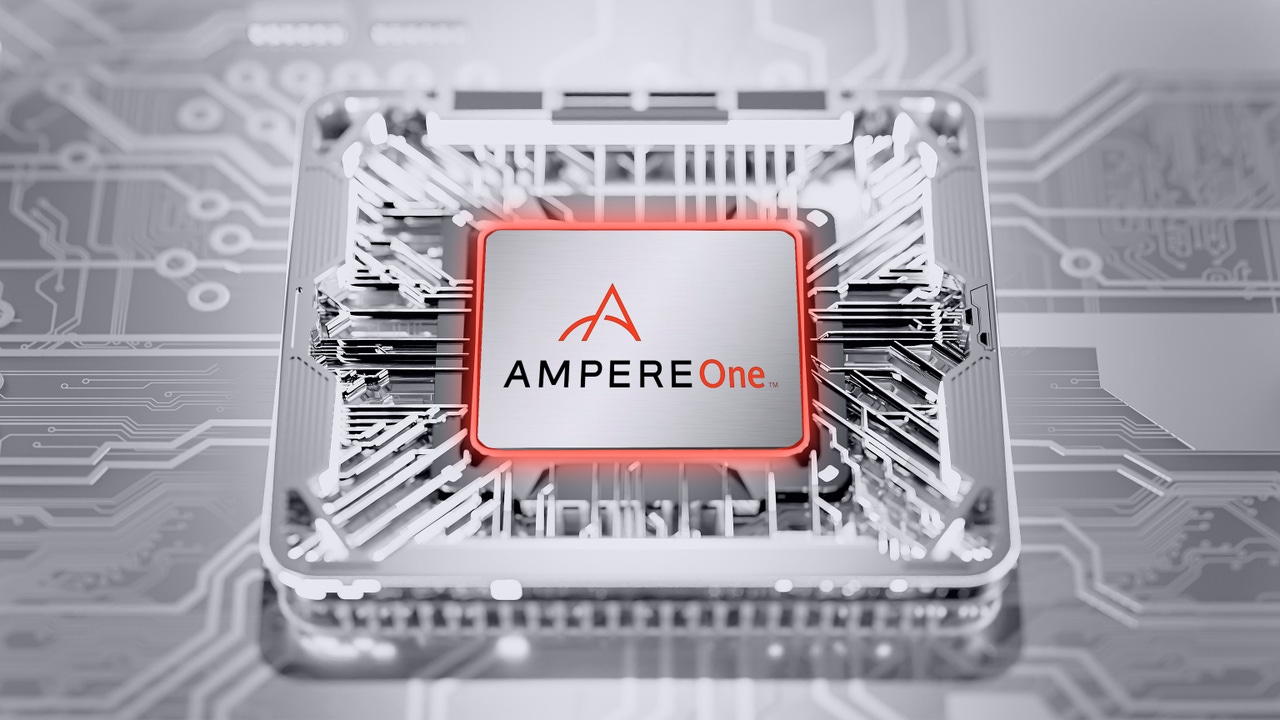Ampere Launches Next-Generation 192-Core Server Processor
The new AmpereOne chip, featuring up to 192 cores and a custom ARM-compatible design, is aimed at cloud providers and enterprises who build their own private clouds.

Ampere Computing, a startup chipmaker led by former Intel president Renee James, today announced a new family of custom-designed, Arm-compatible server processors that feature up to 192 cores – the largest core count currently available in the industry, the company said.
The Santa Clara, Calif.-based company said the new chip, called AmpereOne, is designed to solve a major concern of cloud service providers: meeting the high-performance requirements of its customers while balancing the need to be more energy efficient and sustainable, particularly as energy prices continue to soar.
“AmpereOne is a big step forward because we’re delivering a processor that simultaneously delivers high performance and high power efficiency,” said Ampere Chief Product Officer Jeff Wittich in an interview with Data Center Knowledge. “It’s more compute, less power.”
Since launching in 2018, Ampere has made strides in its effort to become an Arm-based chip alternative to AMD and Intel in the server processor market. Ampere counts Oracle Cloud, Microsoft Azure, Google Cloud, Equinix Metal, Tencent Cloud and Baidu among its cloud provider customers.
Ampere processors are also making their way into enterprise on-premises data centers with Hewlett Packard Enterprise, SuperMicro and other hardware makers selling servers with Ampere processors.
Omdia analyst Manoj Sukumaran said the release of AmpereOne is significant for Ampere and provides a competitive advantage against AMD and Intel, which currently dominate the server chip market with their x86 processors.
“The competition in the cloud-native CPU segment is getting hotter as mainstream CPU vendors like Intel and AMD have picked up the cloud-native proposition and are increasing the core density in their server CPU offerings,” Sukumaran told DCK. “AMD’s 128-core Bergamo is expected to hit the market in the second half of this year, and Intel’s 144-core Sierra Forest is planned for next year, so Ampere is gaining an edge when it comes to core density with AmpereOne.”
AmpereOne’s high-core density and power efficiency will attract cloud providers because they can increase revenue and reduce operating expenditures, which will result in better margins, Sukumaran said.
Furthermore, AmpereOne’s increased core density and lower power profile will enable cloud providers to offer Arm server instances at lower price points, which will likely generate more interest from the broader market, he said. “It lines up very well with the cost optimization drives and sustainability initiatives of enterprise customers.”
In fact, lower costs, higher efficiency and a mature software ecosystem will likely drive adoption of Arm CPUs in the server market, Sukumaran said. Omdia expects the percentage of servers shipped with Arm CPUs will nearly double, from 13% in 2023 to 24% by 2027.
Other Arm CPUs in the market include Amazon Web Service’s Graviton, Fujitsu’s A64FX, Huawei’s Kunpeng 920, Alibaba’s Yitian and the forthcoming Nvidia Grace processor, he said.
Ampere’s New Custom, ARM-Compatible Design
Ampere’s first two processors were built using cores licensed from Arm Ltd. – the 80-core Ampere Altra and the 128-core Ampere Altra Max, which use the 7-nanometer manufacturing process. The company took a different tack with AmpereOne and designed its own custom cores, so it could better tailor its products to meet hyperscalers’ needs.
A year ago, Renee James, Ampere’s CEO, announced that the company was sampling AmpereOne with customers. Now, after a year of sampling, the company announced the new chip is shipping and in production. Wittich declined to state which cloud providers are adopting AmpereOne and making it available to their customers. The cloud providers will make announcements soon, he said.
The AmpereOne family of chips, built using the 5-nanometer manufacturing process, is a custom-designed CPU that uses the Arm instruction Set Architecture (ISA), so any application that was developed and running on Ampere’s earlier Altra processors are compatible, Wittich said.
The upshot: AmpereOne, available in 136 to 192 single-threaded cores and featuring eight channels of DDR5 memory and 128 lanes of PCIe Gen5 IO, offers better performance, scalability and power efficiency than Ampere’s earlier processors, which the company will continue to sell, Wittich said.
“The Altra family runs from 32 to 128 cores, so AmpereOne picks up where Altra leaves off and just extends everything further,” he said.
Wittich expects the use cases for the general-purpose AmpereOne CPU will include AI inferencing, web servers, databases, caching services, media encoding and video streaming. While the new chip is aimed at cloud providers, the company will also market it to enterprises who build private clouds, he said.
Wittich cited two key benchmarks that show AmpereOne provides better performance per rack than AMD’s current Epyc 9654 “Genoa” processor and Intel’s Xeon 8480+ “Sapphire Rapids” processor.
AmpereOne can run 7,296 virtual machines (VMs) per rack, which is 2.9 times more than AMD’s Genoa and 4.3 times more than Intel’s Sapphire Rapids chip, he said. As for generative AI, AmpereOne can produce 2.3 times more frames or images per second than AMD’s Genoa chip, he said.
To be fair, while AmpereOne may outperform AMD and Intel in single-threaded applications, AMD and Intel will outperform AmpereOne in multi-threaded applications, said Jim McGregor, principal analyst at TIRIAS Research.
AmpereOne Will Likely Gain Traction, Analysts Say
Overall, analysts said Ampere’s release of AmpereOne is important for the company’s continued growth and success. The company plans an initial public offering as soon as the economy settles.
“The announcement of AmpereOne is significant because it demonstrates the scalability of the Ampere architecture well beyond the 128 cores of the Altra Max product and beyond what is or will be available from other processor vendors in the near future,” McGregor told DCK. “One of the key advantages of the product is its ability to scale for application workloads almost linearly with additional cores.”
Patrick Moorhead, president and principal analyst at Moor Insights & Strategy, expects good adoption of AmpereOne.
“Ampere has a beachhead at major cloud service providers, and as most enterprises are risk-averse, they usually want to wait until the second version of anything. And with AmpereOne, Ampere’s second-generation design, enterprises will feel more comfortable using it. This will attract enterprises who are looking for maximal VMs and containers per rack, or those looking for the highest efficiency at low power.”
About the Author
You May Also Like








